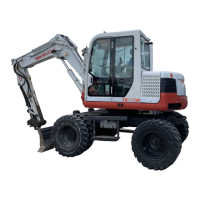Loading and Unloading
1. Apply the trailer’s parking brake and place
stoppers against its tires.
2. Fasten the ramps securely to the trailer
bed so that they will not come off. Set the
ramps to an angle of 15° or less.
3. Line up the center of the trailer bed with
the center of the machine and the center
of the ramps with the center of the tires.
4. Make sure the dozer blade does not hit the
ramps.
5. Lower the hoe attachment as much as
possible, making sure it will not hit the
trailer.
6. Lower the engine speed.
7. Determine the direction on the ramps, then
slowly travel up or down the ramps in site
travel gear (low range), following the signals
of a flagman.
8. Load the machine properly at the prescribed
position on the bed.
Refer to page 99 “Transporting Posture”.
WARNING
The machine may roll or tip over or fall
while loading or unloading it. Take the
following precautions:
�
Select a firm, level surface and keep
sufficient distance from road shoulders.
�
Use loading ramps of adequate strength
and size. Maintain the slope of loading
ramps within 15 degrees. I
f the rumps
are bowed down too low, support them
with poles or blocks.
�
Secure the ramps to the trailer deck.
�
Keep the trailer deck and loading ramps
clean of oil, clay, ice, snow, and other
materials which can become slippery.
Clean the machine tires.
�
Block the trailer so it can not move.
�
Use a signal person when loading and
unloading the machine, and travel
slowly in site travel gear.
�
Never change course on the ramp.
�
Do not slew (swing) on ramps. The
machine may tip over.
�
When slewing (swinging) on the trailer
deck, do so slowly as the footing can be
unstable.
�
Engage the slew (swing) lock after
loading.
�
Block the machine tires and secure the
machine to the trailer deck with load
binders.
When loading or unloading the machine,
be sure to use ramps and following the
procedure below.
W2F001E
Trailer
Ramp
Stopper
15° or less

